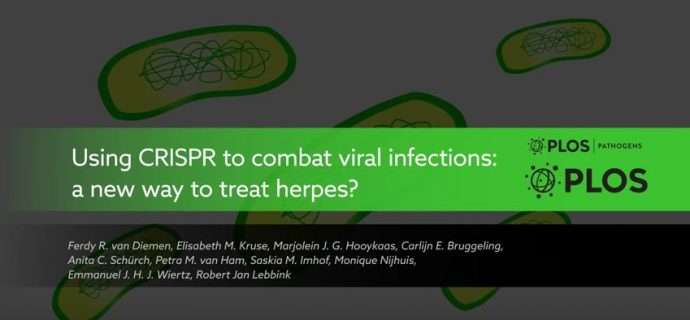Video: CRISPR puts up a fight against persistent herpesviruses

Since its development, CRISPR technology has been applied a range of scientific inquiries, spanning from the genomic editing of Florida orange crops to Zebrafish. In work recently published inPLOS Pathogens, Robert Jan Lebbink (University Medical Center Utrecht, the Netherlands) and colleagues demonstrated that CRISPR can be used to limit viral replication in multiple strains of herpesviruses, in some cases even eliminating the infection altogether.PLOSpartnered with Research Square to bring the findings of this ground-breakingPLOS Pathogensarticle to life in a short animated video depicting the process by which Dr. Lebbink and colleagues used CRISPR technology to inhibit herpesviruses.
所以far, treatment for herpesviruses has been incapable of fully eliminating the virus from its host, meaning the latent infection is lifelong. The virus continues to replicate, which results in flare-ups of disease symptoms in the host. Current treatment for herpesviruses simply mutes thedisease symptomsduring these flare-ups, but fails to fully eliminate the infection, which will remain latent throughout the life course.
Lebbink and colleagues posited that the precision of CRISPR gene editing technology could break the DNA of a herpesvirus, thereby interruptingviral replication. Next, if CRISPR could reach and destroy all existing copies of the virus while also halting replication, then the infection itself could be eliminated.
The researchers tested their theory in three different strains of herpesviruses: Epstein-Barr virus (EBV), the cause of mononucleosis and some cancers; Herpes simplex viruses (HSV-1) and (HSV-2), which cause cold sores and genital herpes respectively; and Human cytomegalovirus (HCMV), which causes congenital herpes.
The results indicate that CRISPR can be used to eliminate replication in all three strains of the virus, but that the technology was so far only successful in actually eradicating EBV. Researchers think this may be because the EBV genome is located in the neurons in dividing cells that are easily accessible to CRISPR. Comparatively, the HSV-1 genome targeted by CRISPR is located in closed-off, non-replicating viral cells, which makes reaching the genome much more challenging.
Q&A with PLOS Pathogens author Dr. Lebbink
Dr. Lebbink discussed the study in a short Q&A with PLOS Social Media Associate, Sara Kassabian. This Q&A has been lightly edited.
How did the development of CRISPR technology facilitate this research?
RL: The technology is really at the core of the research. Without CRISPR/Cas9 we would not have initiated these studies. The CRISPR/Cas9 technology is currently revolutionizing the field of molecular biology research and is opening up many new avenues for potential therapies for many diseases in the future. The power of CRISPR/Cas9 lies in its ease of use, high potency, reproducibility, and limited off-target activity.
What are the implications of your study, for treatment of herpesviruses, public health, etc.?
We first need to explore whether these potent anti-viral activities hold up in animal studies, and eventually humans before they may be applied as a future therapy. The first stop is to perform in vivo studies in animal models for these viruses. If these are successful, testing in humans may be the next step. However, there are several hurdles that need to be taken.
- 安全:系统介绍在我们的细胞can cleave DNA and induce mutations may also induce alterations in the human genome, which can be a serious concern. Although the CRISPR/Cas9 system is quite precise and accurate, this so called off-targeting can occur. Hence, these issues need to be resolved and much research is currently ongoing to make the system safe for future use in humans. Not only to allow treatment of virus-infections, but also to potentially cure certain genetic diseases.
- Delivery, getting highly efficient delivery of the CRISPR/Cas9 system into the desired infected cells in a human is critical. There is already decades of research and development ongoing in academia and industry to allow for efficient delivery of cargo into specific cells in vivo. Much progress has been made, and some types of cells/organs can be quite efficiently targeted by e.g. viral delivery mechanisms.
I think the direct applications to treat EBV and HCMV infections may be challenging, as infected cells can travel to many sites in the body and are hence difficult to reach. For HSV-1, HSV-2, or VZV, delivery may be more straight-forward, as here the viruses reside in limited numbers of neurons at defined areas in the human body, such as the trigeminal ganglia. These sites may be reached by e.g. local administration of neurotropic viral delivery vectors. We envision that delivery of anti-viral CRISPR/Cas9 to latentlyinfected cellsmay destroy the virus invader, curing the cell in question and preventing future outbreaks. Or, alternatively when we cannot remove the latent genome, pre-load the cell with an anti-viral mechanism that can target newly generated virus once the latent virus become activated. Hence, hopefully we can cure infected individuals, or prevent serious damage upon reactivation of these viruses.
What are the next steps for your research team? Will you be using CRISPR/Cas9 in any future studies targeting herpesviruses?
We aim at testing new approaches to also allow targeting of the latent HSV1 genome using the CRISPR/Cas9 system. Additionally, we are working on in vivo model systems to assess the potential therapeutic applications of anti-herpesvirus CRISPRs.
更多的信息:Ferdy R. van Diemen et al. CRISPR/Cas9-Mediated Genome Editing of Herpesviruses Limits Productive and Latent Infections,PLOS Pathogens(2016).DOI: 10.1371/journal.ppat.1005701
This story is republished courtesy of PLOS Blogs:blogs.plos.org.





















